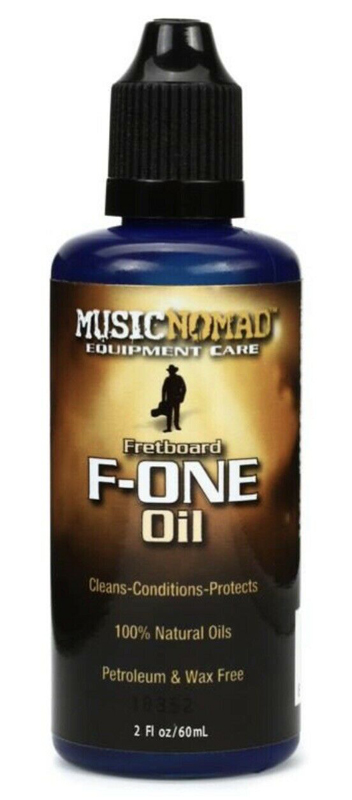
Contemporary Music Instruction and Mentoring
Acoustic Guitar Accessories
(What else do I need besides my guitar?)
After you have carefully selected a guitar (READ THIS FIRST!), here are some things you should consider:
SET UP IS CRITICAL
A problem I commonly see is student guitars that are badly
set up. If the strings are farther away from the
fretboard than they need to be, the guitar will be hard to
play and painful for the fingers. There are several
adjustments that can be made to fix this problem. One
of them involves adjusting the steel rod that is in the neck
(the "truss rod"). I can do this for you during a
lesson, or LINK HERE
to learn how to do it yourself. But the others
(adjusting the nut and the saddle heights) require expertise
and specialized tools. Nearly all guitars, even if
they are brand new, benefit from doing this. For this
reason, I highly recommend that you take your guitar to a
qualified luthier to get a professional setup. (Before
doing so, be sure to read this: LINK
HERE.)
GOOD
STRINGS
Another problem I often see is bad
strings. The strings that come from the factory on new
guitars are very seldom the best strings for a
particular student. Strings can make a HUGE
difference in how easy (or hard) the
guitar is to play, and how wonderful (or crummy) the
guitar sounds. Different types of strings can
be easier to
play, or last longer, or make your guitar sound
better than the strings that are on it
now. For my recommendations
on strings, including strings that sound
fantastic and last much longer, or
strings that are much easier
to play and don't hurt the fingers, LINK
HERE.
TUNER
Every student needs a tuner. Some guitars come with
built-in tuners, which are very handy! If your
acoustic guitar doesn't have a built-in tuner, you can
tune it with any of several available free apps for
Android or Apple phones (my personal favorite is "Pano
Tuner"):
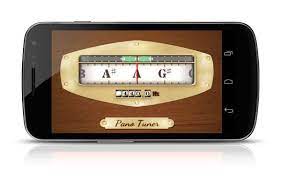
Headstock clip-ons are the most common. The
biggest selling of them is the Snark brand, which are very
popular because they are inexpensive and easy to
use. Unfortunately, they have an extremely weak
design and are notoriously prone to breaking. I do
not recommend them. By far, the very best under-$30
headstock tuner is the TC Electronic Unitune which is the
most accurate tuner on the market, at any price. It
is also very strong and extremely reliable. I highly
recommend this tuner, which is only available at
Sweetwater.com.
(I
personally have one of these for every one of my
performance guitars.)
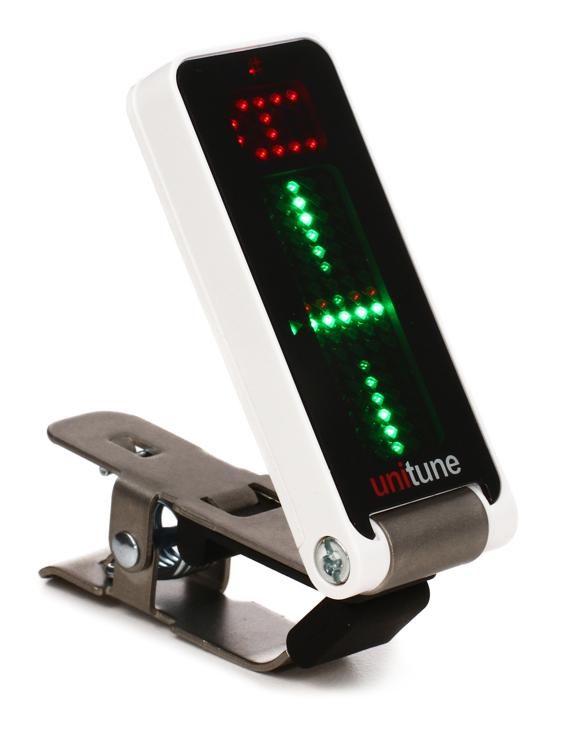
Another option that I highly recommend for acoustic
guitars is the D'Addario
W-CT-15 NS Micro Soundhole Tuner. This is not quite as
accurate and strong as the Unitune, but I live this
tuner because 1) it is always on the guitar and never gets
bumped, dropped, stepped on, or lost somewhere in
the house; and 2) it is hidden from view of the
audience because
it clips
into the sound hole, so you don't have an
ugly tuner sitting on the end of your guitar
during a performance. It is almost
invisible,
it won't get knocked off, it
won't damage the headstock, and you
don't have to remove it when you put the
guitar in its case. It sells for $17.
(I have one of these in every acoustic
guitar I own that doesn't have a built-in
tuner, and also on one that has a built in
tuner because it is more accurate than the
built in tuner.)
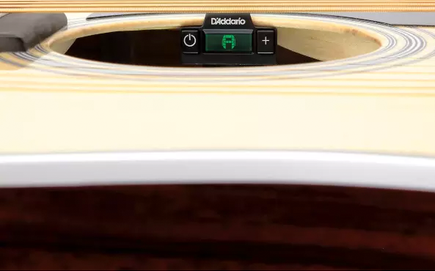
CAPO
Every guitar student needs a capo. The easiest-to-use
and least expensive capos are spring loaded. You
can find cheap spring-loaded
capos from China on Ebay for very low prices, and
they will be okay for a beginner, but they don't
work very
well and and they are made from pot metal
that breaks easily.
If a student is serious about guitar you should
get a better
quality capo. The two I recommend for beginners
are the d'Addario Tri-Action and the Kyser
Quick-Change.
The Kyser Quick-Change is simple, strong, and ugly
because much of the mechanism sticks up where the
audience can see it. I have owned and used three
Kyserís for 20 years and they are easy to use and
never break. However, their springs are very
strong and they cannot be adjusted, which causes them
put the guitar out of tune.
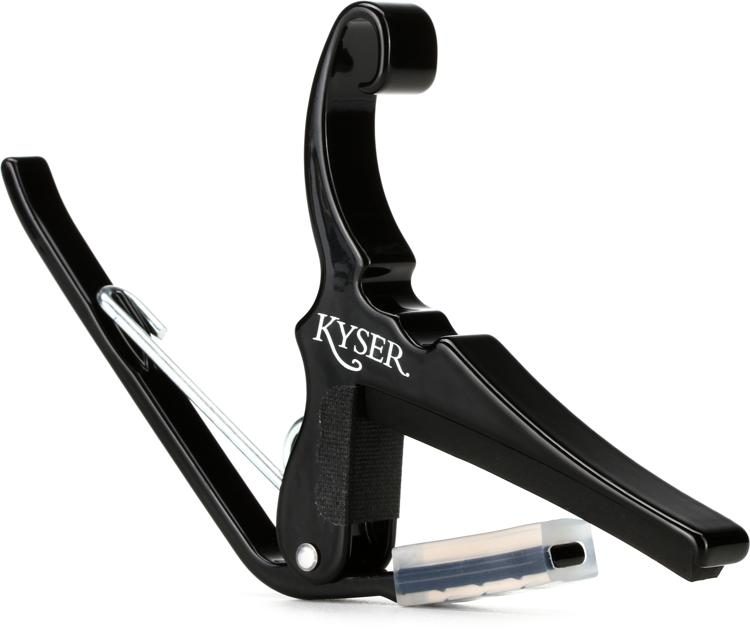
The D'Addario Tri-Action is equally ugly but is far
less obtrusive because the entire mechanism faces away
from the audience, and it has an adjustable spring
tension, which can help to prevent the guitar from
being out of tune while using it.
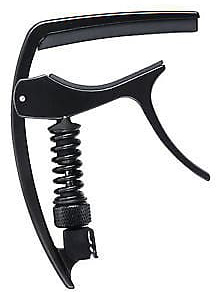
So in the under-$20 price range, the Kyser is a great
capo, but I personally like the D'Addario better.
For advanced and professional players, the very best
capo Iíve found is the G7th Performance steel string
guitar capo. It costs about three times as much
as a Kyser or DíAddario, but itís much nicer because
it is not spring loaded. You control how much
pressure it puts on the strings, simply by how hard
you squeeze it when you put it on. It is small,
elegant, very good looking, extremely strong and
reliable, and capable of putting less pressure on the
strings without buzz than any other capo I've
tried. And it has a lifetime guarantee.
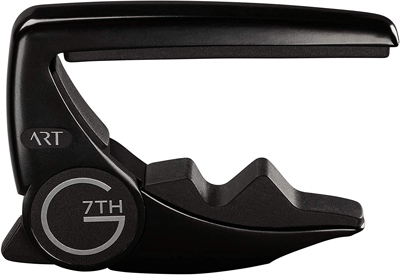
PICKS
All guitarists
need some
picks (sometimes called a "flat pick" or
"plectrum"). It is important to understand that not
all picks are created equal. A 25 cent (or free) medium
pick will work okay, but there are better sounding and playing picks
out there.
For acoustic guitars, everyone has an opinion about
picks. There are dozens of options, and they yield
VERY different results. My criteria are rich tone,
lack of scratching sound, and ease of gliding across the
strings. I have played literally every kind of pick
there is, and
this is what I recommend: For a smooth and rich
tone for most styles of music, the best pick
available (by far) is the D'Andrea Pro Plec pick
(#351, standard 1.5mm rounded triangle). A very
similar pick is also sold as a Taylor Premium Darktone 351 Thermex
Pro. It wouldn't surprise me if they are
made in the same factory, because they are made
of the same material and look identical. For
a bright sounding guitar such as a Taylor, these are the
best sounding, easiest to use, longest lasting acoustic
guitar pick, and they are the only pick I use for six
string acoustic guitar. These picks are much thicker
than standard "medium" picks and are made of a different
type of thermo plastic than other picks. Also, the
edges are rounded and polished, so they give a much
smoother tone and they glide across the strings. They
sell for about $1.00 each.
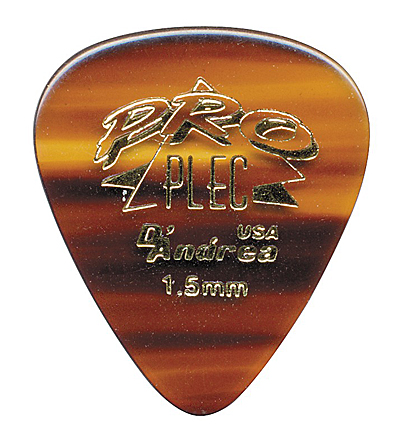
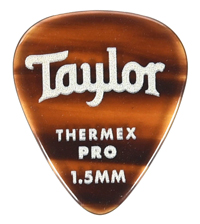
If you have a guitar with a dark tone, a thinner pick will
brighten it up. In that case I would recommend
trying a 1.0mm D'Addario. If that's not bright
enough, try a .8mm D'Addario. For fast picking, try
a .6mm D'Addario. For a super thin pick (which
sounds tinny and I only use it on my 12 string) I like the
very thin,
3-sided Zager picks that are easy to hold, and a bonus
is they store on the tuning pegs of the guitar.
If you have trouble holding onto a pick, and find it
slipping sideways and sometimes flying out of your hand,
don't shop for picks that are easy to hold. There
are several options that are better than buying a crappy
pick that its only selling point is that it's easy to
hold.
One option is to buy a
package of Monster Grips, and apply
one to each side of your favorite
pick. These are thin,
textured, stick-on silicone
pads. For most guitarists,
that will solve the problem.
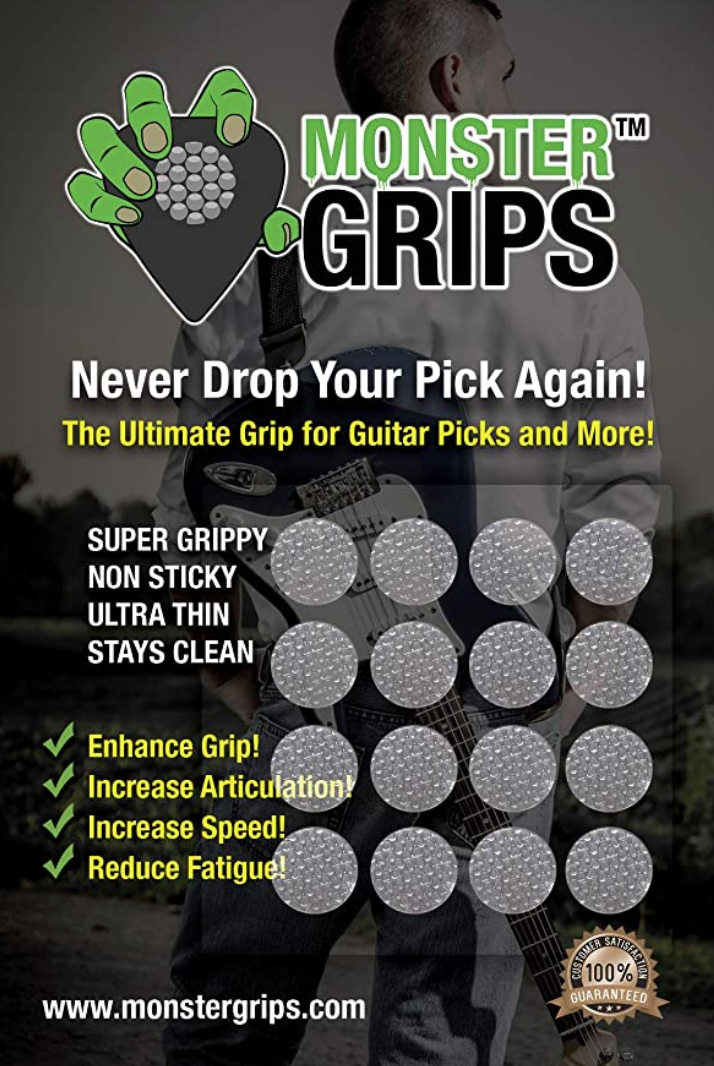
Another
option is to buy some of the round,
colored, silicone plastic, key
identifiers. These work very
well for preventing a pick from
flying out of your hand. If
you still have trouble with the pick
rotating sideways while using it,
you can also use Monster Grips in
conjunction with the key identifiers
for even more control. You can
use different colors for quick
identification of various picks you
may use for different songs during a
performance. You can usually
find 20-30 of them on Ebay for under
$10.
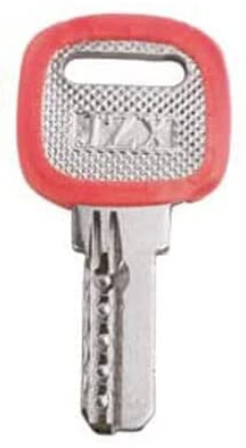
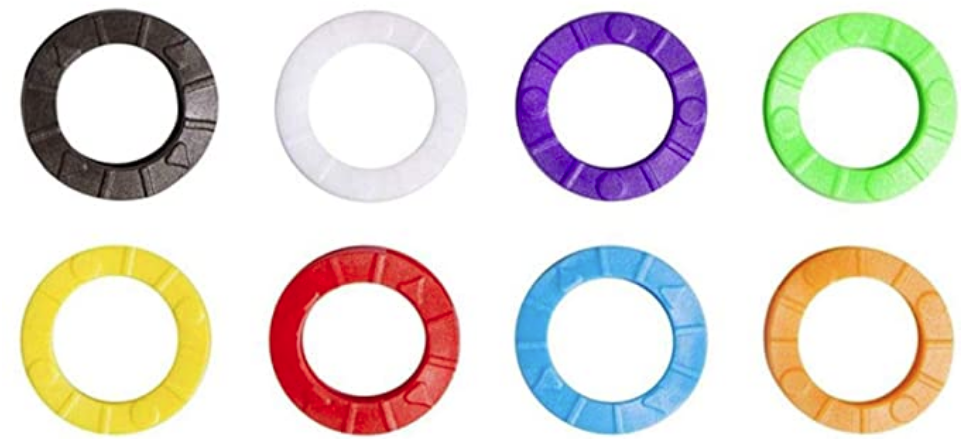
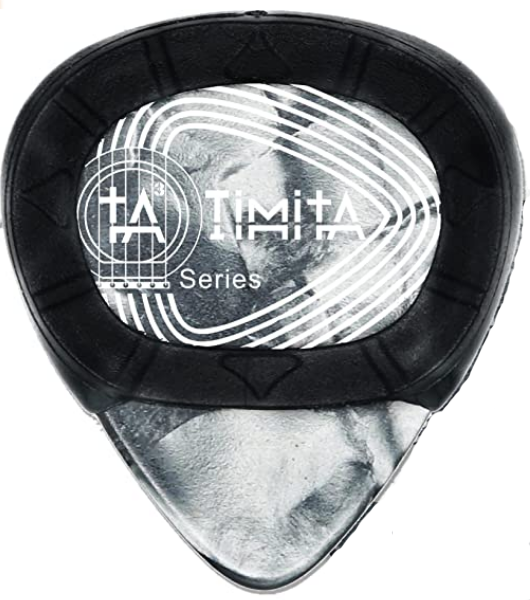
NOTE:
the slot in the rubber that the key
pokes through is not wide enough for a
guitar pick. To use it for a
pick it is helpful to cut the slot
about 5mm wider. Use scissors to
extend the cut.
For
people who have trouble holding onto
a pick because of weak fingers,
carpel tunnel, arthritis,
Parkinson's, or other disability, I
recommend the ergonomic Pykmax UPP
pick holder. It is a fantastic
device that sits comfortably in your
hand and holds the pick for
you. It will hold most
standard picks.
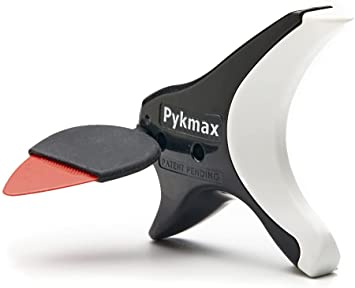
STRAP
Every
guitarist needs a guitar strap for performing.
They are required for performing standing up, and for
some people they are also helpful when seated. A
strap can hold the guitar at a better angle which
helps with wrist and arm fatigue while
practicing. Cotton straps are cheap and
comfortable and they stay in place well, and I
recommend them for most students. Flexible suede
leather straps are also fairly comfortable and don't
slip, but they usually cost quite a bit more.
Nylon straps are very comfortable but they slip too
much on the shoulder, so I do not recommend
them. Stiff leather straps are uncomfortable and
they are expensive, so I also don't recommend
them. For beginners I recommend a strap with
strings on the end that attach to the headstock,
rather than a strap that slips onto the button at the
heel of the neck. This is because it holds the
guitar much better at the ideal angle.
There are no other rules for straps. Just pick
one that is comfortable, that doesn't slip, and that
you think looks good. Your best bet is to take
your guitar to a store and try it with many different
straps. There is a good variety of straps at KSM
Music. That way you can feel them as well as
look at them. There are also plenty online, at
sweetwater.com and other places. One that seems
to have some good looking straps for a fair price is
amunu.rocks (no dot com) but I'm sure there are many
others.
GUITAR CORD
If you have an acoustic-electric or electric guitar, you'll need a 1/4" guitar cord to plug it in. Beginners don't need an expensive cord, but stay away from the cheapest, thin cords. They don't hold up. The D'Addario PW-CGTPRO-15 is an inexpensive medium quality cord that is good enough for home use. It is available from Sweetwater.com for $12. A 15' length is generally sufficient.
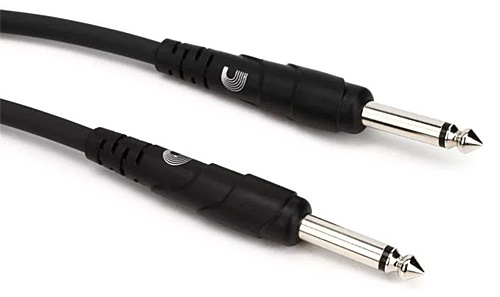
For gigging, you'll need a better cord that will
hold up better. The best bargain I have
found is the EWI GBNC Premium Series cords with
Neutrik straight ends, for $19-21 (available only
at audiopile.net). These are serious cords
for a great price. Everything EWI makes is
extremely high quality for a very reasonable
price.
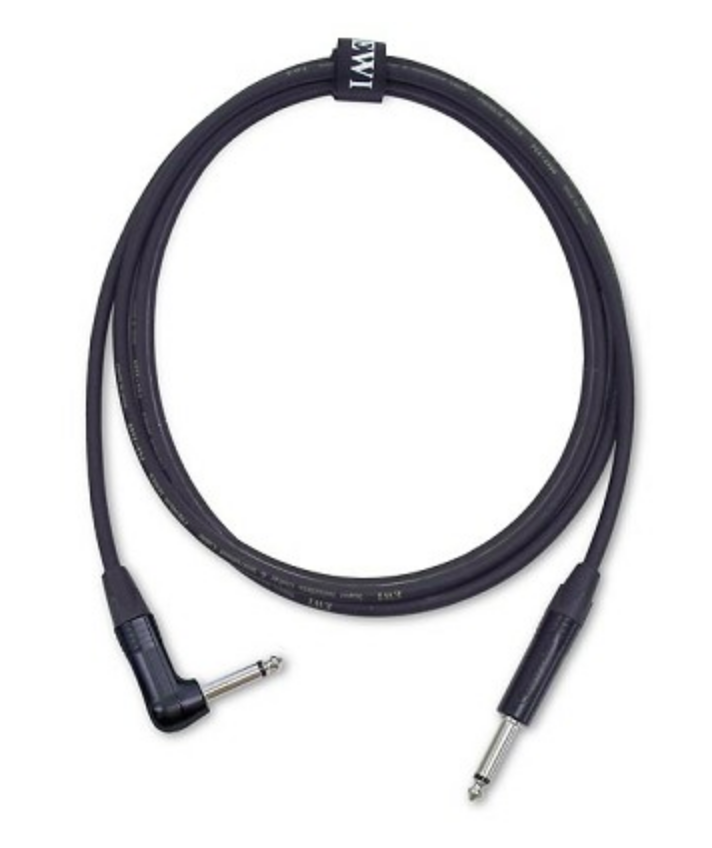
For professionals, I recommend the very best cord
money can buy: George L .155 cords with straight
gold ends. These are the best sounding, most
reliable, strongest, lowest capacitance, easiest
to coil, rebuildable instrument cords ever
made. I have been using them exclusively for
40 years, and have beat them into the ground, and
I've never had to throw one away. I'm still
using the cords I bought 40 years ago, with no
problems. You can make them any
length. They cost about $50 each. The
best place I've found to buy George L cords is
loop-master.com.
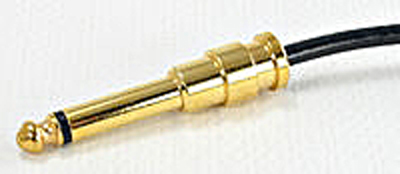
ACOUSTIC GUITAR AMP
I do not recommend buying an "acoustic guitar
amp." They are way overpriced for what you
get, and a small PA system will actually sound
better, anyway. LINK HERE
for a discussion of small PA systems and my
recommendations.
SOUND HOLE PLUG
Have you ever noticed that on TV shows with live
audiences (such as The Voice), that every time a
contestant plays an acoustic guitar on stage,
there is always a black piece of plastic inside
the sound hole?
In live performance situations, especially at high
volumes, most acoustic guitars are notorious for
creating feedback in the PA system. Every
guitar has a resonant frequency. When a PA
speaker plays that note, the sound wave enters the
sound hole of the guitar and starts bouncing
around in there, and that vibration is picked up
by the guitar's pickup, which goes back into the
PA system, and it goes around in a circle and gets
louder and louder, and becomes feedback. If
you get feedback using your acoustic electric
guitar on stage, the easiest and cheapest way to
eliminate the feedback is to plug the sound hole
with a d'Addario Screeching Halt Acoustic Guitar
Feedback Suppressor. That's what the TV
shows do, and it works. It will ruin the
unplugged acoustic sound of the guitar, so always
remove it after a performance. But it will
not have much effect on the amplified sound.
They only cost about $6. Always have one in
your guitar case.
(Obviously, you can't use a sound hole cover if
you have an acoustic guitar with no electronics
and are using a mic on your guitar...)

CASE
OR GIG BAG
Every guitar needs some kind of protection
to store it in your home and to transport it to
other places. New guitars over $500
usually come with a gig bag or case. For
other guitars, gig bags start as cheap as $35
and will work okay if you are careful.
Some of the better quality gig bags have thick
padding and offer more protection, for a little
more money. For even better protection,
hard shell cases are fairly cheap (about $60)
but are heavy, because they are made out of
plywood. For $100+, SKB injection molded
hard shell cases, or SKB soft shell cases with
stiff padding, both provide excellent protection
and are light weight. But beware: guitars
come in many different shapes and sizes.
MAKE ABSOLUTELY SURE that the bag or case you
are buying fits your guitar perfectly without
being too tight and without looseness!
GUITAR STAND
For storing your guitar in your home, I
recommend that you use your gig bag or
case. But when you perform on stage, you
will need a guitar stand to hold the guitar
while you are not using it. There are many
different kinds, but the one I recommend is the
Hercules (either model GS414B PLUS or GS415B
PLUS, whichever you prefer). This stand
has a strong, wide tripod base that is extremely
stable and resistant to tipping over. It
also has a design that does not place the weight
of the guitar onto the the bottom of the body
which sits on the stand; rather, the guitar is
suspended from the neck with an automatic clip
that surrounds the base of the headstock.
It is both faster to use onstage and also safer
for the guitar than other styles of
stands. For those who play two or three
guitars on stage (e.g., acoustic, acoustic 12
string, electric, and/or bass) Hercules also
offers a model that holds two guitars (GS422B
PLUS), and also one that holds three guitars
(GS432B PLUS). (There is another company
that has a similar looking stand but it is not
the same quality and it can damage your
guitars. Stick with the Hercules brand.)
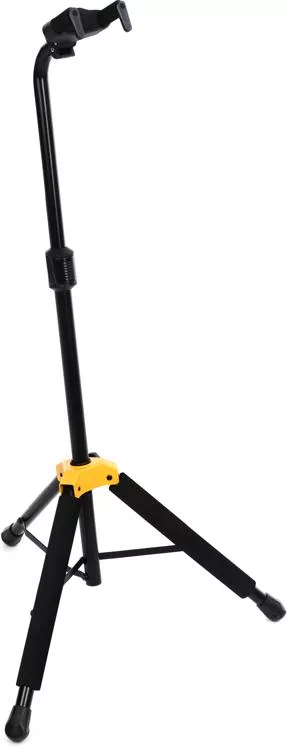
STRING CHANGING TOOLS
(optional)
When you change strings, it
is very nice to have a string winder (aka
"pegwinder"). You
can do it without one, but it's
faster and easier with one.
You can get a junky
Chinese one on Ebay for under $1,
or you can get a decent Dunlop
Series 100 Pegwinder from
sweetwater.com for under $2. But
the best pegwinder I've
found is the MusicNomad
MN221 GRIP. It sells
for about $15, and it is a
BIG step up. Much
nicer to use.
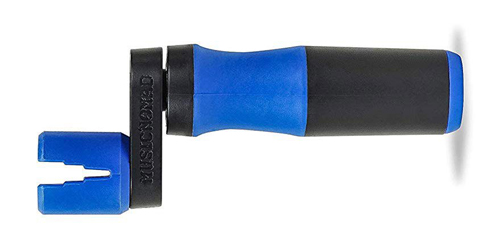
The other tool
you need to change strings is
a pair of
dykes (aka "diagonal
side cutter wire
cutting pliers"),
available
at any
hardware store.
This
tool is used not
only to
cut the strings
to the correct
length
but also to remove
the
bridge pins.
O-PORT
(optional)
One completely optional item that I personally like
for most under-$1,000 steel string acoustic guitars
is the D'Addario
O-Port. It is basically an inverted plastic horn
(a backward megaphone) that attaches to the inside of
the sound hole of a steel string guitar.
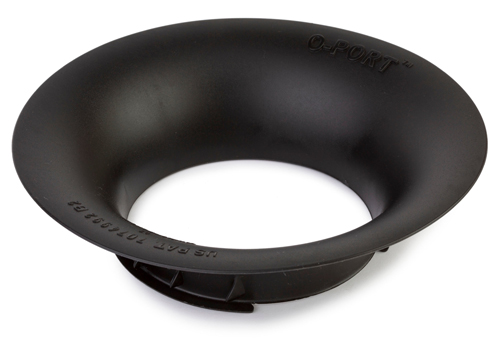
On most inexpensive acoustic guitars, and
also most guitars smaller than full size, this device
increases the overtones, focuses the bass, and increases
the overall volume of the guitar. On an amplified
acoustic-electric guitar, it also helps prevent
feedback. Not as much as a sound hole plug does,
but a little bit. (By the way, a sound hole plug
won't fit if you have one of these in the sound hole...)
I have one on
all my under-$1,000 guitars.
On more expensive guitars, I have found it does not
improve tone, and on my very best guitars it actually
hurts the tone. But on less expensive guitars,
every one I've tried it on has sounded better with it.
NOTE: It is necessary
to either loosen the strings or have them off when
installing and O-Port. So best time to install it is
when changing strings. Also, on some guitars that
have electronics, some modification of the O-Port is
necessary to make it fit around the electronics.
Just some trimming with some scissors, no big deal.
It still works great after it's trimmed.
MUSIC SLOW
DOWNER
I recommend that all students purchase a music player
app for their phones that allows them to slow down
and/or to change the pitch of recorded music. Slowing
down the music is very helpful to guitar and piano
students who are learning to play by ear, and changing
the pitch is very helpful to vocal students.
There are many apps that do this, but there are only
two that I recommend. Both of them have the
limitation that they cannot play music off of
Youtube. Both of them can change speed, change
pitch, and loop a certain section of the song over
and over. Both were
originally $20 and more recently have been priced at
$10-15.
Transcribe + Slow Down Music by Dynamic App Design
LLC
This one only works on iPhone, not Android. It
is harder to set up but easier to use than the other
app. It has a great user interface. I had
trouble getting my songs into the app but young people
are better at that stuff than I am. I donít know
if it works with Apple Music cloud downloads.
The sound quality when slowed down is not as high as
the other app, but most students like this app
better. There is no free trial version.
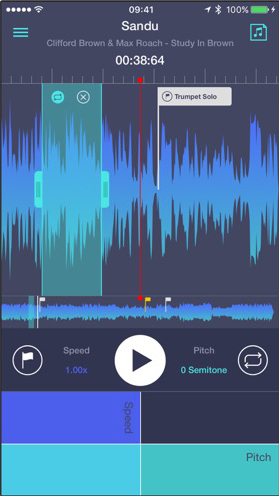
The Amazing Slow Downer by Roni Music
This app has a version for both iPhone and Android,
and it is a much better app for quality sound and ease
of setup. The downside is that the user
interface is not as nice. It works well with
Apple Music. If you get this app, beware that if
you get the free trial version, you canít just simply
click a button and pay to turn on the full
version. The trial version (green icon) is a
completely separate app from the full version (blue
icon). So if you get the trial version and then
decide to buy the full version, you have to delete the
trial app and download the full app, and all your
setup and all the songs you imported are lost and you
have to start from scratch.
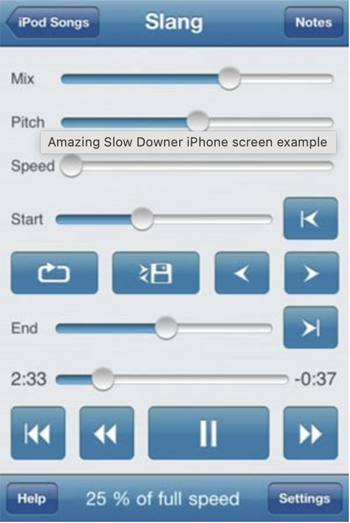
I
have both of these apps on my phone and tablet, and
Amazing Slow Downer is the one I personally prefer,
but many of my students like Transcribe + better.
HEADPHONES
Smartphone
speakers are not suitable for playing
music. They do
not
provide
sufficient
volume nor
bass frequency
response to
hear what
students need
to hear. For guitar
and vocal students, open ear
headphones or high quality ear
buds (either corded or
bluetooth) seem to work
well. (Closed-back
professional headphones that
seal out outside noise are not
as good because it's hard for
the student to hear the
recorded music and their own
guitar at the same
time.) There are too
many options in this category for me to
make a recommendation,
except to say make sure they
have excellent fidelity and
plenty of bass response.
HUMIDIFIER
Please LINK HERE
for a discussion of humidifiers and whether you need
one.
POLISH (optional)
I recommend the occasional use of a high quality,
non-silicone, clear/non-white, spray car wax for
polishing your guitar (everywhere but the fretboard
and bridge). The very best in my opinion is
Turtle Wax "Ice" spray-on car wax, available at any
auto parts store. (This is also my favorite wax
to use on cars, by the way.)
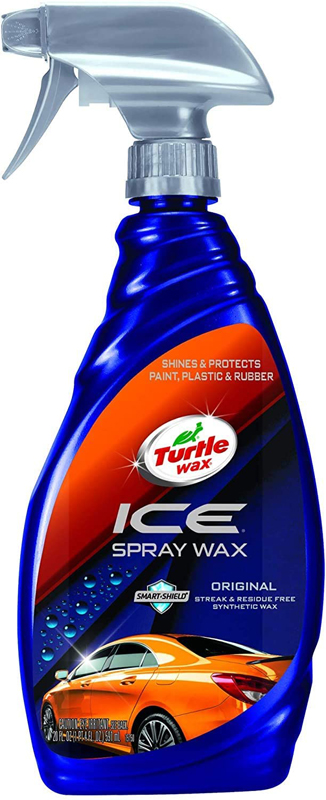
Another option is what Taylor Guitars recommends and
uses in their service shop: Turtle Wax "Express Shine"
spray-on car wax.
Or you can use a little bottle of Dunlop 65 Guitar
Polish Cleaner, which costs more, for a much smaller
bottle, and doesn't last as long, but it's easier to
carry around.
FRETBOARD OIL
The oil I recommend for the fretboard and bridge is
Music Nomad Fretboard F-ONE Oil Cleaner &
Conditioner. LINK HERE
for a discussion of how to use this oil.
